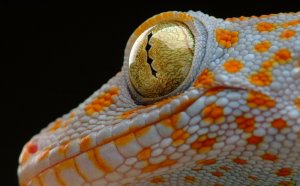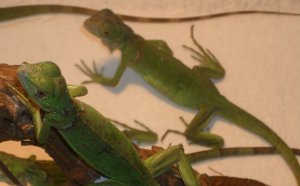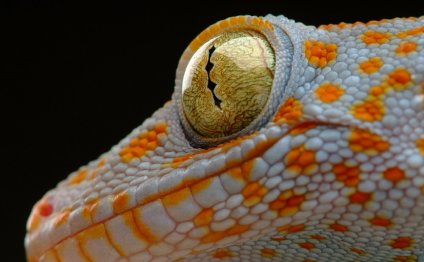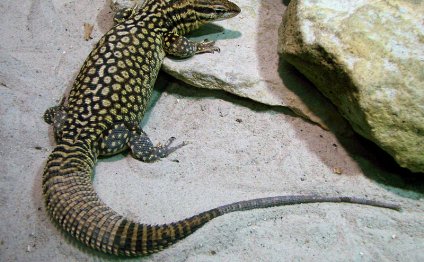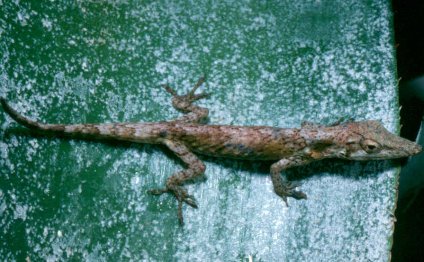
Blue Anole for sale
Care Guide and General Information
Green anoles (Anolis carolinensis) may be a plentiful reptile that are available inexpensively, and are small, but they are reptiles. Their care is vital to their health, and they have a lot to offer. Anoles are small and fast, and overall make a pretty cool pet.
Appearance
Hence the name, green anoles are green in color, but their belly is more of a cream color. Males have a purple or blue flap under their chin that extends and fills with air when mating or warning off other males. Females also have this flap, but it is not as bright or large as a male's.
Green anoles have tails that are nearly twice their body length, that come to a fine tip. Hatchlings and females have a blue stripe down their back, but on a male that stripe will fade away with maturity.
With the proper care and treatment, a green anole can live to be five or more years old. A green anole will typically grow to about nine inches, but some can grow to be a foot long.
Handling and Aggression
These lizards are better off just to watch. Any age green anole will look to make a speedy escape when the chance is possible. Very few can be tamed to sit on your hand, but if you have regular handling sessions with a hatchling and as it grows, handling can be possible.
Diet
Green anoles are not picky eaters, and have a sole diet of insects. Crickets provide a chase, and are the healthiest, but worms like mealworms, superworms, and silk worms work fine. These anoles will keep eating, and you will want to make sure that you do not overfeed them. Overfeeding will shorten their life span, and they will be lethargic, and will behave differently. Gut loading any insect fed is essential so your anole can get the best possible nutrients. Dust all the insects for hatchlings, and every other time for adults.
Housing Requirements
A single or pair of adult anoles will need a minimum of a 20 gallon tank. Hatchlings and juveniles can be kept in a 10 gallon tank until they out grow it. If you house more than two in the same enclosure, add ten more gallons for each anole you add. Do not house males together because they will fight, and potentially kill each other.
Green anoles are good climbers so a higher tank should be used. Always have the lid on the tank or else they will escape. In the tank give them plenty of foliage to hide, and explore in.
Substrate
Substrate is what goes on the bottom of the tank, and since they are more of a tropical species, a moisture absorbing substrate is important. For babies, paper towels can be used and replaced when soiled. Adults can have a loose substrate of non-fertilized potting soil or sphagnum moss. Replace loose substrates every six months.
Shelter
As long as you provide plenty of hiding places in the foliage so as driftwood, hide boxes are not required.
Temperature
The cage should stay at 75F, but a basking spot of 80F should be provided. If an external heating source is needed, avoid under tank heaters because they will not heat the air. Bulbs of the appropriate wattage should be used to create a 12 hour photoperiod. At night, the temperature can drop 10-15F.
Green anoles need UVA or UVB bulbs. Read the instructions that come with the bulb so it is placed right, and working effectively. Water and Humidity
Green anoles need 60-70% humidity constant in the cage to stay hydrated. Dehydration is one of the largest causes of reptile death. The tank should be misted about twice daily, depending on the overall humidity in your house. A water bowl is optional because most will lick water off of leaves and glass.
Cleaning
Paper towels need to be replaced when soiled, and loose substrate replaced about every six months. Remove feces as you see them, and remember to mist the cage. Maintenance is pretty basic, and becomes easier once you get a system down.
Breeding
Be sure to do your homework before trying breeding. The anole is a prolific breeder, but the challenge is the babies. You will have to do just about everything for them until they can take care of themselves.
Most anoles that people will buy are wild caught because they are everywhere in the south. Breeding is getting more popular because of how much healthier the hatchlings will be, and the fact that they have litters up to 12 babies helps too.
In October or early November, lower the heat of both the femaleÄôs and the maleÄôs tanks. Keep temperatures lower until April or May to get them in the mood. Introduce them if you have not already.
A female anole will lay single eggs anywhere in the cage, normally under leaf litter. A lay box can be provided, but may not be used. While the mating and laying process is happening, the temperatures should be slowly rising back to normal. The photoperiod should also be increasing in length. Once you see an egg, place it in an incubator kept at a constant 85F, and it will need to stay moist, but not soaked. Eggs hatch in 35 days, and hatchlings will start eating a few days after they have emerged from their egg. Once they hatch, you have a whole new problem.
Hatchling Care
Young anoles need to eat every day a diet of pinhead crickets and fruit puree. Make sure they all get food to eat, and if any are bullied, separate them from the group until they are caught up. A 10 to 20 gallon tank with several hides is fine for the whole group. A secure lid with a UV bulb with paper towel substrate and a couple pieces of driftwood is an ideal setup. As the hatchlings mature, they should all get split up until they each get their own care.
Conclusion
Anoles are common, cheap pets that should not be underestimated. They live best alone, and can live happily for over 5 years with the right care. Do your research before buying any pet, and have fun watching this attentive, fast, and hungry lizard.
RELATED VIDEO

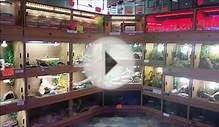
Share this Post
Related posts
Colorful lizard
A very large species of chameleon that is endemic to forests in eastern and northern Madagascar. They reach up to 68 cm (27…
Read MoreIguanas for sale
We have some gorgeous captive-bred Albino Green Iguanas for sale now! They are 2013 babies, eating great, growing fast. Hard…
Read More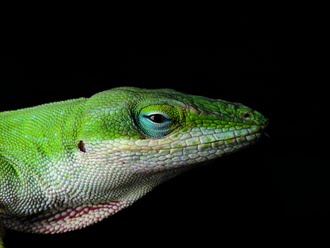 The Carolina anole (Anolis carolinensis) is an arboreal lizard found primarily in the southeastern United States and some Caribbean islands. Other common names include the green anole, American anole and red-throated anole. It is sometimes referred to as the...
The Carolina anole (Anolis carolinensis) is an arboreal lizard found primarily in the southeastern United States and some Caribbean islands. Other common names include the green anole, American anole and red-throated anole. It is sometimes referred to as the...
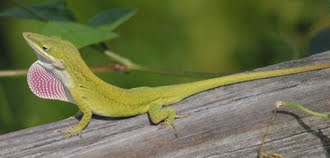 Polychrotidae is a family of lizards commonly known as anoles ( /əˈnoʊliːz/). NCBI places the anole in subfamily Polychrotinae of the family Iguanidae. Four genera are common: Anolis, Norops, Phenacosaurus, and Polychrus.
Polychrotidae is a family of lizards commonly known as anoles ( /əˈnoʊliːz/). NCBI places the anole in subfamily Polychrotinae of the family Iguanidae. Four genera are common: Anolis, Norops, Phenacosaurus, and Polychrus.